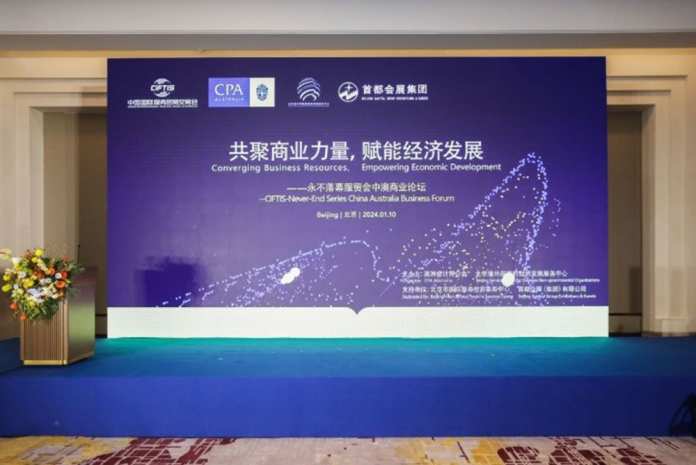“As vital trading partners, a stable China-Australia relations are not only in the interests of both countries, but also in the interests of the world. As Prime Minister Albanese indicated during his visit to China last year, our relationship has taken a ‘very positive step forward.’ Since we signed a free trade agreement in 2015, bilateral trade has doubled, gratifyingly,” noted Rob Donelly, General Manager of Greater China, Austrade, in his opening address at the CIFTIS-Never-End Series China Australia Business Forum held in Beijing on January 10.
Titled “Converging Business Resources, Empowering Economic Development”, the forum vividly demonstrated the necessity of peaceful coexistence and win-win cooperation as the main international theme in the current challenging global context. As Rob Donelly pointed out, China is Australia’s largest trading partner. The trade volume between the two countries has reached 300 billion Australian dollars in 2023, with more than a quarter of Australia’s export revenue comes from China.
China, as the current stabilizer of the global economy, accounts for 18.5% of the global economy, and its overall contribution to world economic growth remains above 30%. Taking Australia-China trade as an example, has undoubtedly injected a shot in the arm into the world economy. However, how to maximize the resilience of China’s economy in today’s extremely complex and challenging world is an issue worth thinking about.

“Global inflation is expected to fall steadily from 8.7% in 2022 to 6.9% in 2023 and 5.8% in 2024 as a result of monetary tightening, as well as core inflation is expected to fall more slowly, with inflation expected in most countries by 2025 In order to return to the target level,” Dr. Zhang Wei, Vice President, Tsinghua University National Institute of Finance pointed out in his keynote speech of the forum.
“We are in the midst of unprecedented changes, and technological changes will eliminate backward industries, such as the rise of e-commerce has led to the depression of physical shopping malls. Beyond all question, innovation will inevitably bring restructuring and subversion. At the same time, due to the impact of the COVID epidemic, the global economy has shown a roller coaster-like characteristic of plummeting and rising. The Federal Reserve quickly cut interest rates to zero and implemented unlimited quantitative easing policies, which have played a key role in mitigating the exogenous impact of the epidemic. Relatively speaking, China’s prudent monetary policy is loose, but its intensity is relatively small.”
According to Dr. Zhang’s prediction, the global economy will see a conditional marginal improvement in 2024. At the same time, he further emphasized that the current level of U.S. inflation is well under control, but there is a greater possibility of a rebound. “If high interest rates are maintained for a long time, it will be a matter of time before the U.S. asset bubble bursts. If interest rates are lowered slowly and effectively, the bubble bursting will be avoided. Compared with the United States, China’s Central Economic Work Conference for 2024 pointed out that future economic recovery is a twists and turns, but the overall long-term positive trend will not change. Under the premise of following the development concept of innovation, coordination, green, openness and sharing, China’s economic growth still has great potential, with sufficient resilience and large space.”
Another guest, Xing Zhaopeng, Senior China Strategist, ANZ China echoed the view. “The labor shortage in the United States has caused inefficient prosperity in the service industry, and its continuation may cause American Dutch disease. However, China’s current overall labor supply exceeds demand, thus there will be no impact caused by labor shortage. In 2023, the growth brought by total factor productivity in the United States was negative 1.5%, while China’s total factor growth was positive 1.5% during the same period. In 2024, our economic growth momentum will mainly come from inventory reconstruction, forming a virtuous cycle of green consumption and investment to accelerate destocking. Our green production capacity must be released to the maximum extent, which will inevitably be the biggest growth point of China’s economy in 2024.”


